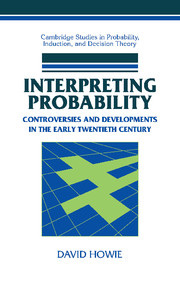Book contents
- Frontmatter
- Contents
- Acknowledgments
- 1 Introduction
- 2 Probability up to the Twentieth Century
- 3 R.A. Fisher and Statistical Probability
- 4 Harold Jeffreys and Inverse Probability
- 5 The Fisher–Jeffreys Exchange, 1932–1934
- 6 Probability During the 1930s
- 7 Epilogue and Conclusions
- Appendix 1 Sources for Chapter 2
- Appendix 2 Bayesian Conditioning as a Model of Scientific Inference
- Appendix 3 Abbreviations Used in the Footnotes
- Bibliography
- Index
4 - Harold Jeffreys and Inverse Probability
Published online by Cambridge University Press: 07 July 2009
- Frontmatter
- Contents
- Acknowledgments
- 1 Introduction
- 2 Probability up to the Twentieth Century
- 3 R.A. Fisher and Statistical Probability
- 4 Harold Jeffreys and Inverse Probability
- 5 The Fisher–Jeffreys Exchange, 1932–1934
- 6 Probability During the 1930s
- 7 Epilogue and Conclusions
- Appendix 1 Sources for Chapter 2
- Appendix 2 Bayesian Conditioning as a Model of Scientific Inference
- Appendix 3 Abbreviations Used in the Footnotes
- Bibliography
- Index
Summary
JEFFREYS'S BACKGROUND AND EARLY CAREER
Harold Jeffreys's scientific interests were well developed by his arrival in 1910 at St. John's College Cambridge on a mathematics scholarship. Some interests, such as a lifelong fascination with celestial mechanics, had been inspired from the wide reading of an only child, which included popular scientific works by Sir Robert Ball, G.F. Chambers, and Sir George Darwin. Others were influenced by the elemental countryside of his Northumberland home. Greasy slag heaps and mountains of ore dominated the landscape of the colliery village of Fatfield, and the air was thickened with the smoke from nearby iron and shipbuilding works. The area was rich in both geological and botanical terms. Rocks from any period from the Silurian to the Jurassic were visible within a day's train journey, while certain plant species were unique to the coal measures. Encouraged by his parents, both able gardeners, Jeffreys took up naturalism early, recording in small black notebooks wildlife and rock formations studied during cycling trips around the locality.
Jeffreys was unusually well prepared for undergraduate study at Cambridge, having already obtained a B.Sc. in the general science course from Armstrong College (then part of Durham University, now of the University of Newcastle). The catholic approach at Armstrong had fostered Jeffreys's early interests: the geology course was supplemented by regular excursions to the local countryside, and Jeffreys was encouraged to apply his year of chemistry to study the development processes of his hobby of photography.
- Type
- Chapter
- Information
- Interpreting ProbabilityControversies and Developments in the Early Twentieth Century, pp. 81 - 127Publisher: Cambridge University PressPrint publication year: 2002

